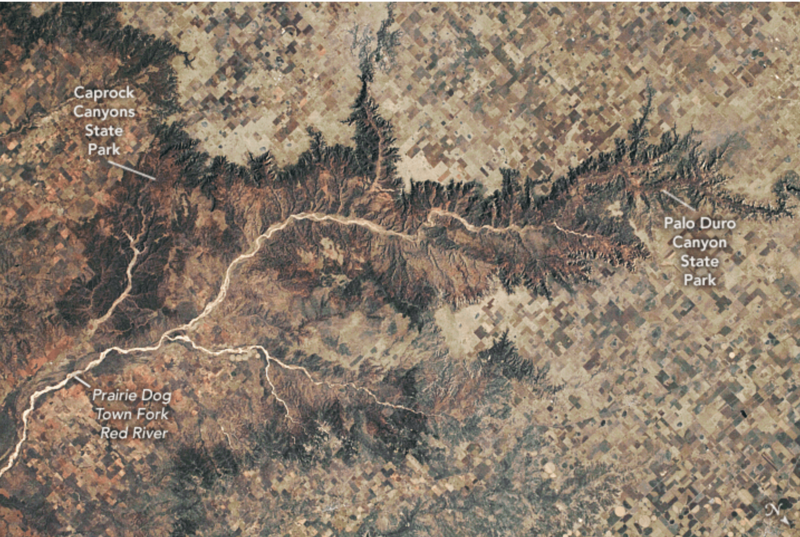Image: Palo Duro and Caprock Canyons, TX

Description: While in orbit over the Texas Panhandle, an astronaut on the International Space Station (ISS) photographed Palo Duro and Caprock Canyons, areas that provide insight into Texas geologic and human history. Dark, intricate canyon edges branch out into the High Plains, where agricultural fields and ranches tile the landscape. A fork of the Red River, named the Prairie Dog Town Fork Red River, runs through the canyons. (Note that the photo has been oriented with north toward the bottom in order to prevent relief inversion by the shadows.) Almost one million years ago, the headwaters of the Prairie Dog Town Fork Red River began carving their way through the Palo Duro area. The canyon is now about 800 feet (240 meters) deep and about 20 miles (30 kilometers) across, making it the second largest canyon in the United States behind Arizona’s Grand Canyon. Comprised of sedimentary rock layers, the oldest exposed rocks in Palo Duro were deposited more than 250 million years ago, during the Permian Period. The first known humans in the area are thought to have hunted bison and mammoths here, with fossils of extinct animals embedded in the sedimentary rocks. Human artifacts, such as stone tools and rock art, have been found throughout the canyons and date back thousands of years. Today agriculture and ranching spread across the surrounding landscape, though the Palo Duro and Caprock Canyon systems are both reserved as Texas state parks.
Title: Palo Duro and Caprock Canyons, TX
Credit: https://earthobservatory.nasa.gov/images/149854/grand-canyon-of-texas
Author: ISS Crew Earth Observations Facility and the Earth Science and Remote Sensing Unit, Johnson Space Center, NASA
Permission: Public domainPublic domainfalsefalse This file is in the public domain in the United States because it was solely created by NASA. NASA copyright policy states that "NASA material is not protected by copyright unless noted". (See Template:PD-USGov, NASA copyright policy page or JPL Image Use Policy.) Warnings: Use of NASA logos, insignia and emblems is restricted per U.S. law 14 CFR 1221. The NASA website hosts a large number of images from the Soviet/Russian space agency, and other non-American space agencies. These are not necessarily in the public domain. Materials based on Hubble Space Telescope data may be copyrighted if they are not explicitly produced by the STScI.[1] See also Template:PD-Hubble and Template:Cc-Hubble. The SOHO (ESA & NASA) joint project implies that all materials created by its probe are copyrighted and require permission for commercial non-educational use. [2] Images featured on the Astronomy Picture of the Day (APOD) web site may be copyrighted. [3] The National Space Science Data Center (NSSDC) site has been known to host copyrighted content. Its photo gallery FAQ states that all of the images in the photo gallery are in the public domain "Unless otherwise noted."
Usage Terms: Public domain
License: Public domain
Attribution Required?: No
Image usage
The following page links to this image:

